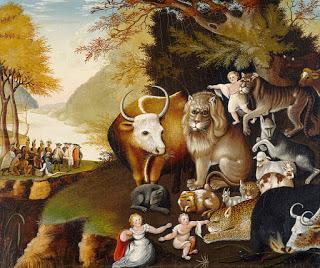
In several comments yesterday, I recommended Jacob J. Erickson's recent essay at Religion Dispatches entitled "The Martyrdom of Cecil the Lion." What I like about Erickson's approach to this story is that he frames it as a story about "a larger theological history of environmental, gendered, and colonial injustice." I think he's right to see the story in this way.
Here's an excerpt from his essay:
But these hunting-acts are just high-profile features in a much deeper, insidious lineage; hunting-acts like these fall within a larger theological history of environmental, gendered, and colonial injustice.
Zimbabwe is home to what are often referred to as the "Big Five" in Africa. The African elephant, the Cape buffalo, the African leopard, the rhinoceros, and, of course, the African lion compose the celebrity group of animals for the hunter. They each made this list not because of size or rarity, but because of the danger supposedly involved in hunting them on foot. Each of these can be quite ferocious to a human being endangering them.
The term "Big Five" came into being during Africa’s colonial and neocolonial periods, with Western hunters traveling to East Africa in particular to collect their trophies, tales of epic spiritual and natural struggle, and human conquest. A distinctively American form of Big Game hunting can be traced as well. Famously, Teddy Roosevelt headed to East Africa in the name of science (and Western Masculinity, I would add) to bag the Big Five for himself. The term morphed into use for the tourist industry, safari-goers paying big bucks for guides to track down the five.
Such activities, for sport, usually served to demonstrate the God-given "dominion" of human beings over the "chaotic" and "morally dubious" wilderness of the natural world, women, other cultures, and queer bodies.. In that narrative, Western rationality conquers and colonizes nature and "civilizes" the African continent. The violence committed towards human and nonhuman life alike occurs together.
And then Erickson cites his colleague and friend Peter Anthony Mena (the link he provides points to Mena's Twitter feed, where I don't spot the statement to which Erickson is pointing):
The murder of this amazing creature is as much a symptom of white wealth and privilege that seeks to perpetuate false ideas of domination and violence, as the racist, sexist, homophobic, and classist ideologies that undergird the murders of minoritized, marginalized, and oppressed people. In other words, this heinous act, is as much a part of the problems many of us must be troubled by and concerned with.
Erickson teaches religion and environmental studies at St. Olaf College in Northfield, Minnesota, and Pena teaches history of Christianity at Phillips Theological Seminary in Tulsa, Oklahoma.
The photo of Quaker painter Edward Hicks's "Peaceable Kingdom," which is at the National Gallery of Art in Washington, D.C., has been uploaded to Wikimedia Commons for sharing.

